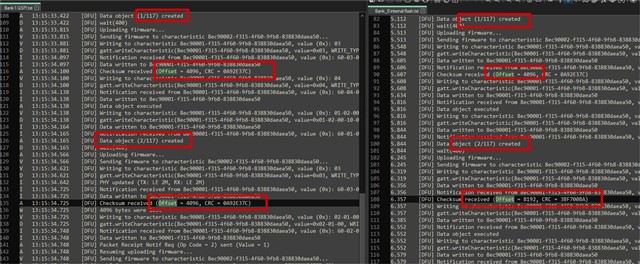Hi
I'm chnaging the Secure Bootloader to an external falsh for bank1, connected with QSPI.
In the function on_data_obj_write_request is the call for nrf_dfu_flash_store (file nrf_dfu_req_handler.c
static void on_data_obj_write_request(nrf_dfu_request_t * p_req, nrf_dfu_response_t * p_res)
{
NRF_LOG_DEBUG("Handle NRF_DFU_OP_OBJECT_WRITE (data)");
if (!nrf_dfu_validation_init_cmd_present())
{
/* Can't accept data because DFU isn't initialized by init command. */
p_res->result = NRF_DFU_RES_CODE_OPERATION_NOT_PERMITTED;
return;
}
uint32_t const data_object_offset = s_dfu_settings.progress.firmware_image_offset -
s_dfu_settings.progress.firmware_image_offset_last;
if ((p_req->write.len + data_object_offset) > s_dfu_settings.progress.data_object_size)
{
/* Can't accept data because too much data has been received. */
NRF_LOG_ERROR("Write request too long");
p_res->result = NRF_DFU_RES_CODE_INVALID_PARAMETER;
return;
}
uint32_t const write_addr = m_firmware_start_addr + s_dfu_settings.write_offset;
/* CRC must be calculated before handing off the data to fstorage because the data is
* freed on write completion.
*/
uint32_t const next_crc =
crc32_compute(p_req->write.p_data, p_req->write.len, &s_dfu_settings.progress.firmware_image_crc);
ASSERT(p_req->callback.write);
ret_code_t ret =
nrf_dfu_flash_store(write_addr, p_req->write.p_data, p_req->write.len, p_req->callback.write);
if (ret != NRF_SUCCESS)
{
/* When nrf_dfu_flash_store() fails because there is no space in the queue,
* stop processing the request so that the peer can detect a CRC error
* and retransmit this object. Remember to manually free the buffer !
*/
p_req->callback.write((void*)p_req->write.p_data);
return;
}
/* Update the CRC of the firmware image. */
s_dfu_settings.write_offset += p_req->write.len;
s_dfu_settings.progress.firmware_image_offset += p_req->write.len;
s_dfu_settings.progress.firmware_image_crc = next_crc;
/* This is only used when the PRN is triggered and the 'write' message
* is answered with a CRC message and these field are copied into the response.
*/
p_res->write.crc = s_dfu_settings.progress.firmware_image_crc;
p_res->write.offset = s_dfu_settings.progress.firmware_image_offset;
}
There is a callback which is needed:
ret_code_t ret =
nrf_dfu_flash_store(write_addr, p_req->write.p_data, p_req->write.len, p_req->callback.write);
inside this function I use the QSPI function:
hal_qspi_write(&p_src, len, (dest & EXTERNAL_FLASH_ADDRESS_LOWER_BYTES), (void*)callback))
which at the end is calling the nrfx function nrfx_qspi_write.
Here I should have a callback, but I don't know what I should implement.
The original callback in the nrf_fstorage_write is implemented like this:
return (p_fs->p_api)->write(p_fs, dest, p_src, len, p_context);
ret_code_t nrf_fstorage_write(nrf_fstorage_t const * p_fs,
uint32_t dest,
void const * p_src,
uint32_t len,
void * p_context)
{
NRF_FSTORAGE_PARAM_CHECK(p_fs, NRF_ERROR_NULL);
NRF_FSTORAGE_PARAM_CHECK(p_src, NRF_ERROR_NULL);
NRF_FSTORAGE_PARAM_CHECK(p_fs->p_api, NRF_ERROR_INVALID_STATE);
NRF_FSTORAGE_PARAM_CHECK(len, NRF_ERROR_INVALID_LENGTH);
/* Length must be a multiple of the program unit. */
NRF_FSTORAGE_PARAM_CHECK(!(len % p_fs->p_flash_info->program_unit), NRF_ERROR_INVALID_LENGTH);
/* Source and destination addresses must be word-aligned. */
NRF_FSTORAGE_PARAM_CHECK(addr_is_aligned32(dest), NRF_ERROR_INVALID_ADDR);
NRF_FSTORAGE_PARAM_CHECK(addr_is_aligned32((uint32_t)p_src), NRF_ERROR_INVALID_ADDR);
NRF_FSTORAGE_PARAM_CHECK(addr_is_within_bounds(p_fs, dest, len), NRF_ERROR_INVALID_ADDR);
return (p_fs->p_api)->write(p_fs, dest, p_src, len, p_context);
}
Now the DFU is strating on bank1 but the App is generating an error because data is missing because of this callack I guess?
I was following this topic:
https://devzone.nordicsemi.com/f/nordic-q-a/48961/dfu-with-external-qspi-memory



